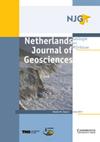Review of induced seismicity in geothermal systems worldwide and implications for geothermal systems in the Netherlands
IF 2.3
2区 地球科学
Q3 GEOSCIENCES, MULTIDISCIPLINARY
Netherlands Journal of Geosciences-Geologie En Mijnbouw
Pub Date : 2019-01-01
DOI:10.1017/njg.2019.6
引用次数: 37
Abstract
Abstract Geothermal energy is a viable alternative to gas for the heating of buildings, industrial areas and greenhouses, and can thus play an important role in making the transition to sustainable energy in the Netherlands. Heat is currently produced from the Dutch subsurface through circulation of water between two wells in deep (1.5–3 km) geothermal formations with temperature of up to ∼100 °C. As the number of these so-called doublets is expected to increase significantly over the next decades, and targeted depths and temperatures increase, it is important to assess potential show-stoppers related to geothermal operations. One of these potential hazards is the possibility of the occurrence of felt seismic events, which could potentially damage infrastructure and housing, and affect public support. Such events have been observed in several geothermal systems in other countries. Here we review the occurrence (or the lack) of felt seismic events in geothermal systems worldwide and identify key factors influencing the occurrence and magnitude of these events. Based on this review, we project the findings for seismicity in geothermal systems to typical geothermal formations and future geothermal developments in the Netherlands. The case study review shows that doublets that circulate fluids through relatively shallow, porous, sedimentary aquifers far from the crystalline basement are unlikely to generate felt seismic events. On the other hand, stimulations or circulations in or near competent, fractured, basement rocks and production and reinjection operations in high-temperature geothermal fields are more prone to induce felt events, occasionally with magnitudes of M > 5.0. Many of these operations are situated in tectonically active areas, and stress and temperature changes may be large. The presence of large, optimally oriented and critically stressed faults increases the potential for induced seismicity. The insights from the case study review suggest that the potential for the occurrence of M > 2.0 seismicity for geothermal operations in several of the sandstone target formations in the Netherlands is low, especially if faults can be avoided. The potential for induced seismicity may be moderate for operations in faulted carbonate rocks. Induced seismicity always remains a complex and site-specific process with large unknowns, and can never be excluded entirely. However, assessing the potential for inducing felt seismic events can be improved by considering the relevant (site-specific) geological and operational key factors discussed in this article.全球地热系统诱发地震活动的综述及其对荷兰地热系统的启示
地热能是建筑、工业区和温室供暖的可行替代方案,因此可以在荷兰向可持续能源过渡中发挥重要作用。目前,荷兰地下的热量是通过深地热地层(1.5-3公里)的两口井之间的水循环产生的,温度高达100°C。由于这些所谓的双重层的数量预计将在未来几十年显著增加,目标深度和温度也会增加,因此评估与地热开采相关的潜在阻碍因素非常重要。这些潜在的危险之一是可能发生有震感的地震事件,这可能会破坏基础设施和住房,并影响公众的支持。在其他国家的几个地热系统中也观察到这种事件。本文回顾了世界各地地热系统中有感觉地震事件的发生(或缺乏),并确定了影响这些事件发生和震级的关键因素。在此基础上,我们预测了荷兰地热系统中地震活动性的研究结果,以及典型的地热地层和未来的地热开发。案例研究表明,在远离结晶基底的相对较浅、多孔的沉积含水层中循环流体的双重层不太可能产生有感觉的地震事件。另一方面,高温地热田的压裂、基底岩内或附近的增产或循环以及生产和回注作业更容易诱发感觉事件,有时震级为M > 5.0。许多这些作业都位于构造活跃地区,应力和温度变化可能很大。大型、最佳定向和临界应力断层的存在增加了诱发地震活动的可能性。从案例研究综述中得出的见解表明,在荷兰的几个砂岩目标地层中,地热作业发生M > 2.0级地震活动的可能性很低,特别是在可以避免断层的情况下。在断裂的碳酸盐岩中,诱发地震活动的可能性不大。诱发地震活动始终是一个复杂的、特定地点的过程,具有很大的未知因素,永远不能完全排除。然而,通过考虑本文中讨论的相关(特定地点的)地质和操作关键因素,可以改进诱发感觉地震事件的潜力评估。
本文章由计算机程序翻译,如有差异,请以英文原文为准。
求助全文
约1分钟内获得全文
求助全文
来源期刊
CiteScore
4.00
自引率
25.90%
发文量
14
审稿时长
>12 weeks
期刊介绍:
Netherlands Journal of Geosciences - Geologie en Mijnbouw is a fully open access journal which publishes papers on all aspects of geoscience, providing they are of international interest and quality. As the official publication of the ''Netherlands Journal of Geosciences'' Foundation the journal publishes new and significant research in geosciences with a regional focus on the Netherlands, the North Sea region and relevant adjacent areas. A wide range of topics within the geosciences are covered in the journal, including "geology, physical geography, geophyics, (geo-)archeology, paleontology, hydro(geo)logy, hydrocarbon exploration, modelling and visualisation."
The journal is a continuation of Geologie and Mijnbouw (published by the Royal Geological and Mining Society of the Netherlands, KNGMG) and Mededelingen Nederlands Instituut voor Toegepaste Geowetenschappen (published by TNO Geological Survey of the Netherlands). The journal is published in full colour.

 求助内容:
求助内容: 应助结果提醒方式:
应助结果提醒方式:


